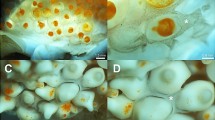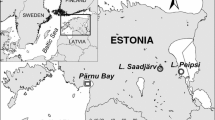Abstract
The embryonic development and the level of dependency of the embryos from the maternal organism were investigated for Centroscymnus coelolepis. During the development, there is a 22–32% loss of organic matter and gains of 95–122% and 29–46% on moisture and inorganic matter, respectively. Only 28–48% of the initial yolk energy is conserved in embryos, being the remaining used in catabolism. In late pregnancy, the epithelium thickness of uterine villi decreases and vascularity increases. Results suggest that only water and minerals are transferred from the mother to the embryos. Monounsaturated fatty acids are the main type of fatty acids representing 48% of the total yolk fatty acid content, followed by polyunsaturated (30%) and saturated fatty acids (18–21%).








Similar content being viewed by others
References
Ackman RG, Eaton CA, Linne BA (1975) Differentiation of freshwater characteristics of fatty acids in marine specimens of the Atlantic sturgeon (Acipenser oxyrhynchus). Fish Bull 73:838–845
AOAC (1998) Official methods of analysis, 16th edn. 4th revision. Association of Official Analytical Chemistry, Washington
Bandarra N, Batista I, Nunes ML, Empis JM, Christie WW (1997) Seasonal changes in lipid composition of sardine (Sardina pilchardus). J Food Sci 62:40–42
Bell MV, Tocher DR (1989) Molecular species composition of the major phospholipids in brain and retina from rainbow trout (Salmo gairdneri). Biochem J 264:909–915
Boehlert GW, Yoklavich MM (1984) Reproduction, embryonic energetics, and the maternal-fetal relationship in the viviparous genus Sebastes (Pisces: Scorpaenidae). Biol Bull 167:354–370
Boehlert GW, Kusakari M, Shimizu M, Yamada J (1986) Energetics during embryonic development in kurosoi, Sebastes schlegeli Hilgendorf. J Exp Mar Biol Ecol 101:239–256
Braccini JM, Hamlett WC, Gillanders BM, Walker TI (2007) Embryo development and maternal-embryo nutritional relationships of piked spurdog (Squalus megalops). Mar Biol 150:727–737
Carrier JC, Pratt HL, Castro JI (2004) Reproductive biology of elasmobranchs. In: Carrier JC, Musick J, Heithaus MR (eds) Biology of sharks and their relatives. CRC Press, USA, pp 269–286
Clarke MW, Connolly PL, Bracken JJ (2001) Aspects of reproduction of the deep-water sharks Centroscymnus coelolepis and Centrophorus squamosus from west of Ireland and Scotland. J Mar Biol Assoc UK 81:1019–1029
Cohen Z, Von Shak A, Richmond A (1988) Effect of environmental conditions on fatty acid composition of the red algae Porphyridium cruentum: correlation to growth rate. J Phycol 24:328–332
Evans RP, Parrish CC, Brown JA, Davis PJ (1996) Biochemical composition of eggs from repeat and first-time spawning captive Atlantic halibut (Hippoglossus hippoglossus). Aquaculture 139:139–149
Figueiredo I, Moura T, Neves A, Gordo LS (2008) Reproductive strategy of leafscale gulper shark, Centrophorus squamosus, and Portuguese Dogfish, Centroscymnus coelolepis, on the Portuguese continental slope. J Fish Biol 73:206–225
Galli C, Risé P (2006) Origin of fatty acids in the body: endogenous synthesis versus dietary intakes. Eur J Lipid Sci Technol 108:521–525
Garcia VB, Lucifora LO, Myers RA (2008) The importance of habitat and life history to extinction risk in sharks, skates, rays and chimaeras. Proc R Soc B 275:83–89
Girard M, Du Buit MH (1999) Reproductive biology of two deep-water sharks from the British Isles, Centroscymnus coelolepis and Centrophorus squamosus (Chondrichthyes: Squalidae). J Mar Biol Assoc UK 79:923–931
Grogan ED, Lund R (2004) The origin and relationships of early chondrichthyes. In: Carrier JC, Musick J, Heithaus MR (eds) Biology of sharks and their relatives. CRC Press, USA, pp 3–31
Guallart J, Vicent JJ (2001) Changes in composition during embryo development of the gulper shark, Centrophorus granulosus (Elasmobranchii Centrophoridae): an assessment of maternal-embryonic nutritional relationships. Env Biol Fish 61:135–150
Hamlett WC, Hysell MK (1998) Uterine specializations in elasmobranchs. J Exp Zool 282:438–459
Hamlett WC, Koob TJ (1999) Female reproductive system. In: Hamlett WC (ed) Sharks, skates and rays: the biology of elasmobranch fishes. John Hopkins University Press, Baltimore, pp 398–443
Hamlett WC, Kormanik G, Storrie M, Stevens B, Walker TI (2005a) Chondrichthyan parity, lecithotrophy and matrotrophy. In: Hamlett WC (ed) Reproductive biology and phylogeny of chondrichthyes: sharks, batoids and chimaeras. Science Publishers Inc, Enfield, pp 395–434
Hamlett WC, Knight DP, Pereira FTV, Steele J, Sever DM (2005b) Oviducal glands in Chondrichthyans. In: Hamlett WC (ed) Reproductive biology and phylogeny of chondrichthyes: sharks, Batoids and Chimaeras. Science Publishers Inc, Enfield, New Hampshire, pp 301–360
Heiden TCK, Haines AN, Manire C, Lombardi J, Koob TJ (2005) Structure and permeability of the egg capsule of the bonnethead shark, Sphyrna tiburo. J Exp Zool 303A:577–589
Hisaw FL, Albert A (1947) Observations on the reproduction of the spiny dogfish (Squalus acanthias). Biol Bull 92:187–199
Jollie WP, Jollie LG (1967) Electron microscopic observations on accommodations to pregnancy in the uterus of the spiny dogfish, Squalus acanthias. J Ultrastruct Res 20:161–178
Jump DB, Clarke SD (1999) Regulation of gene expression by dietary fat. Annu Rev Nutr 19:63–90
Koob TJ, Cox DL (1990) Introduction and oxidation of catechols during the formation of the skate (Raja erinacea) egg capsule. J Mar Biol Assoc UK 70:395–411
Lepage G, Roy CC (1986) Direct transesterification of all classes of lipids in one-step reaction. J Lipid Res 27:114–119
Lombardi R (1996) Postzygotic maternal influences and the maternal-embryonic relationship of viviparous fishes. Am Zool 36:106–115
Love RM (1970) The chemical biology of fishes, vol 1. Academic Press, New York
Musick JA, Ellis JK (2005) Reproductive evolution of Chondrichthyans. In: Hamlett WC (ed) Reproductive biology and phylogeny of chondrichthyes: sharks, batoids and chimaeras. Science Publishers Inc, Enfield, pp 45–79
Parr Instrument Co (1997) 1261 Isoperibol bomb calorimeter—operating instruction manual no. 242M. Illinois, USA
Parr Instrument Co (2003) Using an 1107 semimicro oxygen bomb in a 1261 calorimeter—operating instruction manual no. 260M. Illinois, USA
Pethybridge H, Daley R, Virtue P, Nichols P (2010) Lipid composition and partitioning of deepwater chondrichthyans: inferences of feeding ecology and distribution. Mar Biol 157:1367–1384
Pratt HL, Casey JG (1990) Shark reproductive strategies as a limiting factor in directed fisheries, with a review of Holden’s method of estimating growth parameters. NOAA Tech Rep NMFS 90:97–109
Ranzi S (1932) Le basi fisio-morfologiche dello sviluppo embrionale dei selaci Parte I. Pubbl Staz Zool Napoli 12:256–260
Ranzi S (1934) Le basi fisio-morphologiche dello sviluppo embrionale dei selaci. Parte II e III. Pubbl Staz Zool Napoli 13:331–437
Remme JF, Synnes M, Stoknes IS (2005) Chemical characterisation of eggs from deep-sea sharks. Comp Biochem Physiol B 141:140–146
Reznick D, Callahan H, Llauredo R (1996) Maternal effects on offspring quality in poeciliid fishes. Amer Zool 36:147–156
Sampath H, Ntambi JM (2005) Polyunsaturated fatty acid regulation of genes of lipid metabolism. Annu Rev Nutr 25:317–340
Sargent JR, Bell JG, Bell MV, Henderson RJ, Tocher DR (1995) Requirement criteria for essential fatty acids. J Appl Ichthyol 11:183–198
Sargent J, McEvoy L, Estevez A, Bell G, Bell M, Henderson J, Tocher D (1999) Lipid nutrition of marine fish during early development: current status and future directions. Aquaculture 179:217–229
Stehmann M (2002) Proposal of a maturity stages scale for oviparous and viviparous cartilaginous fishes (Pisces, Chondrichthyes). Arch Fish Mar Res 50:23–48
Storrie MT, Walker TI, Laurenson LJ, Hamlett WC (2008) Gestational morphogenesis of the uterine epithelium of the gummy shark (Mustelus antarcticus). J Morphol 270:319–336
Tinkle DW, Hadley NF (1973) Reproductive effort and winter activity in the viviparous montane lizard Sceloporus jarrovi. Copeia 1973:272–277
Trinnie FI, Walker TI, Jones PL, Laurenson LJ (2009) Reproductive biology of the eastern shovelnose stingaree Trygonoptera imitata from south-eastern Australia. Mar Fresh Res 60:845–860
Verissimo A, Gordo LS, Figueiredo I (2003) Reproductive biology and embryonic development of Centroscymnus coelolepis in Portuguese mainland waters. ICES J Mar Sci 60:1335–1341
Visentainer JV, Noffs MA, Carvalho PO, Almeida VV, Oliveira CC, Souza NE (2007) Lipid content and fatty acid composition of 15 marine fish species from the southeast coast of Brazil. J Amer Oil Chem Soc 84:543–547
Vitt LJ (1974) Reproductive effort and energy comparisons of adults, eggs and neonates of Gerrhonotus coeruleus principis. J Herpetol 8:165–168
Walker TI (2007) Spatial and temporal variation in the reproductive biology of gummy shark Mustelus antarcticus (Chondrichthyes: Triakidae) harvested off southern Australia. Mar Fresh Res 58:67–97
Wiegand MD (1996) Composition, accumulation and utilization of yolk lipids in teleost fish. Rev Fish Biol Fish 6:259–286
Wiegand MD, Johnston TA, Martin J, Leggett WC (2004) Variation in neutral and polar lipid compositions in ova in ten reproductively isolated populations of walleye (Sandrus vitreus). Can J Fish Aquat Sci 61:110–121
Wourms JP, Grove BD, Lombardi J (1988) The maternal-embryonic relationship in viviparous fishes. In: Hoar WS, Randall DJ (eds) Fish physiology, vol 11B. Academic Press, San Diego, pp 1–134
Wrisez F, Lechenault H, Leray C, Haye B, Mellinger J (1993) Fate of yolk lipid in an oviparous elasmobranch fish, Scyliorhinus canicula (L). In: Walther BT, Fyhn HJ (eds) Physiological and biochemical aspects of fish development. University of Bergen, Bergen, pp 315–322
Yano K (1995) Reproductive biology of the black dogfish, Centroscyllium fabricii, collected from waters off western Greenland. J Mar Biol Ass UK 75:285–310
Yano K, Tanaka S (1987) Reproductive organs of deep sea sharks, Centroscymnus owstoni and C. coelolepis. J Fac Mar Sci Technol Tokai Univ 25:57–67
Acknowledgments
We thank Quivari-Cação that allowed the easy collection and without costs of the samples and also Inês Farias (IPIMAR), Ana Rita Vieira (IPIMAR) and Ana Neves (FCUL) for the help during sampling. Special thanks to Bárbara Serra-Pereira (IPIMAR) for expertise help and to Júlia Ferreira (IPIMAR), Lab. Bromatologia (IPIMAR) and Lab. Fecundidade (IPIMAR) for the all the facilities during the experimental work. Finally, we thank the anonymous reviewers for their valuable suggestions and critics on the manuscript. T. Moura was funded by a grant from Fundação para a Ciência e a Tecnologia (SFRH/BD/29052/2006). This study was partially supported by the Project TUBAPROF (MARE 22-05-01-FEDER-00028, co-financed by the EU) and PNAB EU/DCR.
Author information
Authors and Affiliations
Corresponding author
Additional information
Communicated by U. Sommer.
Rights and permissions
About this article
Cite this article
Moura, T., Nunes, C., Bandarra, N. et al. Embryonic development and maternal–embryo relationships of the Portuguese dogfish Centroscymnus coelolepis . Mar Biol 158, 401–412 (2011). https://doi.org/10.1007/s00227-010-1568-4
Received:
Accepted:
Published:
Issue Date:
DOI: https://doi.org/10.1007/s00227-010-1568-4




